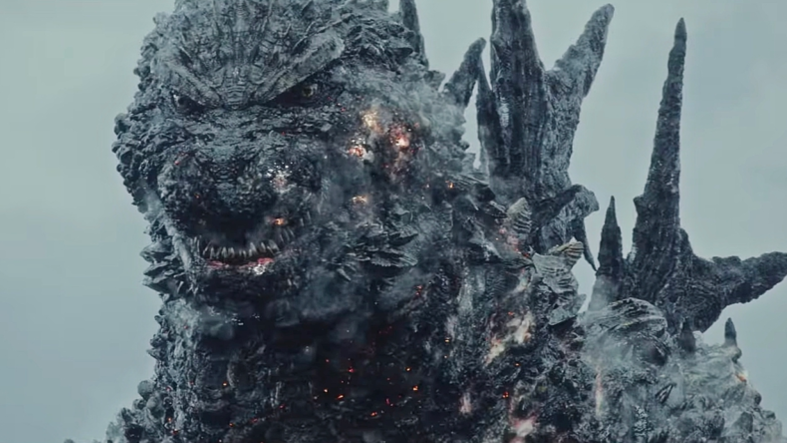‘Godzilla Minus One’ Review: Toho’s King of The Monsters Makes A Triumphant Return

You don’t bring a battleship to an atomic breath fight. That’s a lesson that comes hard for certain ships in Godzilla Minus One, the first live-action Japanese film to bring the King of Monsters roaring back to life in his home country since 2016. Shin Godzilla revived the creature from a 12-year domestic hibernation, and a Netflix anime trilogy kept the gunner’s seat warm, but it’s been a while since we’ve seen civilians in Tokyo wailing in terror at the sight of him.
Never mind Legendary’s MonsterVerse; this is a Toho Studios production. The movie, written and directed by Takashi Yamazaki, approaches Godzilla from the angle of a period piece, beginning in the final days of World War II. Protagonist Koichi Shikishima (Ryunosuke Kamiki) is a kamikaze pilot who lands on Odo Island in 1945, having failed to obey orders to die for his country. It’s the same island where the monster first wreaked havoc on black-and-white village huts in the original 1954 film. But here, it’s reimagined as a Japanese military encampment.
Deep sea fish soon come bobbing up in the water in what becomes a telltale sign that a scaly and scary disaster is about to strike. It’s not long before air raid sirens go off and Godzilla himself comes ashore, chomping and stomping his way through a maintenance crew.
Also Read: The 4 Gayest Godzilla Movies
As it moves by land and sea, Shikishima brings some Spielbergian flourishes to the creature, likening it to a dinosaur in dialogue, framing its fins as shark-like in the ocean, and visually echoing kills and other scenarios from Jurassic Park and Jaws. He also handles the film’s visual effects, which are rickety in places in a way that speaks to the lack of a Hollywood budget. On the plus side, Godzilla Minus One doesn’t spend too much time trying to hide its effects in night scenes in the way of so many errant modern blockbusters. If anything, the movie seems determined to buck that trend early on by literally shining a spotlight on Godzilla.
A common criticism of some Godzilla movies is that they don’t show the monster enough. In terms of doling out screen time for him, this one’s not any better or worse than what’s come before it. It starts off strong, then settles in with character development and post-war drama (sometimes melodrama). The supporting cast includes Sakura Ando (Shoplifters) as Shikishima’s Tokyo neighbor, Sumiko, and Minimi Hamabe (Shin Kamen Rider) as his uninvited house guest, Noriko, a woman caring for a baby orphaned by the air raids.
Also Read: ‘Godzilla x Kong’: Will This Be an Enemies-To-Lovers Slashfic?
A surrogate family forms amid several time jumps as Shikishima finds work on a minesweeper so he can afford American powdered milk. Kuranosuke Sasaki, Hidetaka Yoshioka, and Yuki Yamada bring likeability to their roles as the crew of the wooden boat (just call it the Orca), which can hunt the many magnetic mines left in the waters off Japan’s coasts. The movie does start to drag the longer Godzilla is offscreen, but a montage with gentle music and smiling faces registers as a short-lived vision of happiness. This is the folly of those who dare to dream when the monster’s still out there.
Godzilla Minus One excels most in its widescreen set pieces, including an attack on the Ginza shopping district, shown in trailers. (Ginza is right down the street from the venue where Godzilla Minus One premiered as the closing film of the Tokyo International Film Festival.) If you want to hear a needle drop with Akira Ifukube’s classic Godzilla music, and see the monster with a train car hanging out of his mouth again, you won’t be disappointed.
The title Godzilla Minus One positions this as a film where the starting point for the monster’s victims is less than zero. Just when you thought things couldn’t get any worse in life (here depicted as a war-ravaged city), in comes the King of Monsters. Built around Shikishima’s character arc, Godzilla Minus One could just as well be described as “Godzilla vs. the Kamikaze Pilot.” It’s as much a film set post-war as it is a film about someone’s personal war to overcome a seemingly insurmountable problem.
Also Read: ‘Cloverfield’: America’s Post 9/11 ‘Godzilla’
When calamity descends, how do we react (or fail to act)? Do we confront the terror in our sights head-on—in the self-destructive, kamikaze way—or does the will to live trump the will to fight? And are those two options mutually exclusive?
Whether this is relatable and fertile ground for a kaiju film, or whether Shikishima’s PTSD and Godzilla nightmares only offer a trite twist on the trauma theme in horror, may divide Western audiences. However, the best Godzilla films are more than just monster movies. They pull subtext from the creature, treating him as a nuclear metaphor (as in 1954) or as a symbol of natural disaster and a foil for ineffectual government bureaucracy (as in Shin Godzilla).
Below the mushroom clouds and black rain, Godzilla Minus One peels back another intimate layer, bringing the audience down to the human level where the survivors are. Children cry, loved ones die, and now a great and terrible beast stalks the earth. We’ve seen this horror swim up from the deep before, and it will likely do so again on celluloid. In the meantime, Godzilla Minus One has as much majesty as melodrama, and if it pulls its punches in moments, maybe we’ve all earned a brief respite and a chance at Plus One.
Summary
Below the mushroom clouds and black rain, Godzilla Minus One peels back another intimate layer, bringing the audience down to the human level where the survivors are.
Categorized:Reviews

